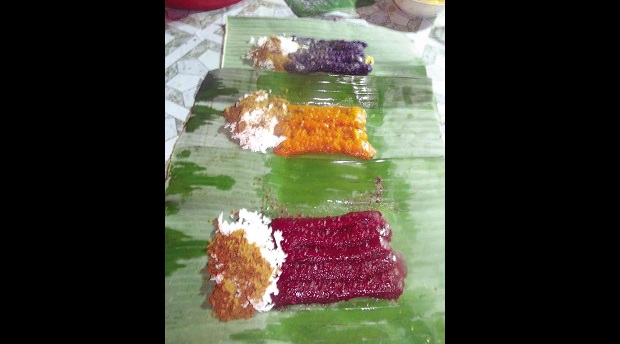In Cavite, ‘puto bumbong’ comes in different colors

A LITTLE accident made the trick in these yellow and red-colored “puto bumbong,” now being sold in Maragondon town, Cavite province. But the taste of the old Filipino Christmas delicacy remains. LOUIE LAGAC/CONTRIBUTOR
Evelyn Tabojara just had to give her nephew a good scolding. She asked him to prepare a good batch of “puto bumbong” for the first night of Misa de Gallo but came back with a little surprise.
If it were a little or too much of the food color, it did not matter, she said. “They turned up sky blue! I told him it would make people wonder,” she said.
But that little mistake has now made Tabojara’s puto bumbong popular among churchgoers in her town of Maragondon in Cavite province, particularly those attending Misa de Gallo, the nine-day dawn Masses of the Catholic Church that herald the birth of Jesus Christ.
Puto bumbong, the deep purple Filipino delicacy, is Tabojara’s bread and butter. All year round, she sells spaghetti or lomi outside the church in Maragondon, Cavite, but all this changes when the “ber” months begin; she instead sells the popular Christmas delicacy, based on her grandmother’s recipe.
When the dawn Masses begin, Tabojara opens her puto bumbong stand late in the afternoon and stays up until the next morning. She cannot manage her daytime eatery anymore during the holiday season.
Article continues after this advertisementColor purple
Article continues after this advertisementSo when Tabojora, a 41-year-old single parent, decided she could not simply dispose of the messed-up batch of puto bumbong last Sunday evening, she decided to sell it anyway.
To her surprise, the odd color caught the attention of one customer, who took a picture of the sky blue puto bumbong and posted it on Facebook.
“Many people got interested. The other night, someone asked me if I could make them yellow,” Tabojara said in a phone interview on Thursday evening.
At one time during the week, she served steaming red-colored puto bumbong.
“It’s just a matter of food color but the taste is all the same,” said Tabojara, taking back the scolding she gave her nephew, who discovered the little trick by accident.
People have come to know the puto bumbong as purple, the natural color of the glutinous rice called pirurutong that the delicacy is traditionally made of. But as the pirurutong, Tabojara said, had become rare and expensive, they found the ordinary white malagkit (sticky) rice as a substitute.
“But even [the malagkit rice] is becoming expensive, too. Last year, it was P40 per kilo but this year, it costs around P65 to P75,” she said. As a result, she, too, had to increase the selling price from P15 to P20 per bag.
Tabojara learned the painstaking process of soaking the malagkit, grinding and refining the mixture for hours, when she was in Grade 5. She remembered she had to stand on a stool to see how her grandmother did it.
“I’m glad I learned it, otherwise how are we to survive?” she said. After her husband left them, Tabojara had to raise her children, one in high school and two in preschool, all by herself.
She said her eldest had learned the recipe, “although I would rather they finish their schooling and have a better future.”
But she intends to keep making puto bumbong not only as a family tradition but a Christmas custom in her community.